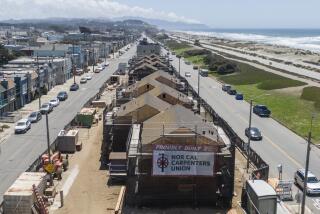West’s Housing Prices Are On Track, Fed Says
Bubble or no bubble?
Though economists at the Federal Reserve Bank of San Francisco won’t speculate on whether home prices have soared too high, they say that California and the Western region don’t appear any more vulnerable to a price drop than the rest of the nation.
That’s the word in Tuesday’s quarterly Fed report that tracks the economic health of the San Francisco Federal Reserve District, which includes California, Nevada, Arizona, Utah, Idaho, Oregon, Washington, Alaska and Hawaii.
In the first quarter, the district’s residential real estate market performed right in step with the nation’s, according to the report, with home prices rising 5.7% and sales up 11% compared with the same period a year ago. California outpaced the pack, with home prices increasing 7.4% and sales up 20%.
Such increases have some observers whispering the B-word for California, but Fed economist Mary Daly said the recent spike had to be put in context.
Part of the reason California’s recent home-price appreciation looks so steep is that the residential real estate market was mired in a deep trough for much of the last decade.
In the late 1980s, prices soared, then plunged starting in the early ‘90s as the defense industry collapsed. Only in recent years have California prices begun outpacing those of the nation again.
When measuring the state’s boom-bust-boom pattern over the long U.S. economic expansion, it turns out that home-price appreciation in California lagged behind that of the nation, Daly said.
From the first quarter of 1991 through the first quarter of this year, home prices rose 57% across the United States as a whole but only 41% in California, according to the Fed data.
“No one can answer the question as to whether we’re in a bubble or not,” Daly said.
“What we can say is that ... even with the recent, rapid run-up in values, California doesn’t look out of line with the rest of the nation.”
The housing supply in California likewise looks tight compared with the rest of the country, Daly said, as measured by the amount of housing being constructed in the state relative to its job creation.
From 1991 to 2000, the district, excluding California, created 1.5 jobs for every new housing permit issued--a ratio considered ideal by many regional planners and just slightly above that for the nation.
Over the same period, California created two new jobs for every housing permit issued in the state. From 1995 to 2000, that ratio rose to 3.6--more than double that of the nation and the rest of the district.
The higher the ratio, the higher the pent-up demand for housing. Daly said that figure has eased of late since California, like the rest of the nation, isn’t creating many new jobs.
Still, she said, strong demand probably would keep the state’s housing market tight in coming quarters.
More to Read
Inside the business of entertainment
The Wide Shot brings you news, analysis and insights on everything from streaming wars to production — and what it all means for the future.
You may occasionally receive promotional content from the Los Angeles Times.










